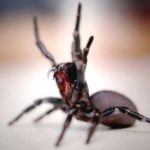 Creepy
Creepy  Creepy
Creepy  Movies and TV
Movies and TV 10 Movies That Get Elite Jobs Right, According to Experts
 Weird Stuff
Weird Stuff 10 Times Real Laws Were Based on Bizarre Hypotheticals
 Animals
Animals 10 Inspiring Tales of Horses Being Human
 Mysteries
Mysteries Top 10 Haunting Facts About the Ghost Ship MV Alta
 History
History 10 Surprising Stories About the Texas Rangers
 Humans
Humans 10 Philosophers Who Were Driven Mad by Their Own Theories
 Miscellaneous
Miscellaneous 10 Video-Game-Worthy Weapons and Armors from History
 Weird Stuff
Weird Stuff 10 Psychics Who Accurately Predicted Wartime Events
 The Arts
The Arts 10 Pieces of Art Inspired by a Broken Heart
 Creepy
Creepy 10 Death Superstitions That Will Give You the Creeps
 Movies and TV
Movies and TV 10 Movies That Get Elite Jobs Right, According to Experts
 Weird Stuff
Weird Stuff 10 Times Real Laws Were Based on Bizarre Hypotheticals
Who's Behind Listverse?

Jamie Frater
Head Editor
Jamie founded Listverse due to an insatiable desire to share fascinating, obscure, and bizarre facts. He has been a guest speaker on numerous national radio and television stations and is a five time published author.
More About Us Animals
Animals 10 Inspiring Tales of Horses Being Human
 Mysteries
Mysteries Top 10 Haunting Facts About the Ghost Ship MV Alta
 History
History 10 Surprising Stories About the Texas Rangers
 Humans
Humans 10 Philosophers Who Were Driven Mad by Their Own Theories
 Miscellaneous
Miscellaneous 10 Video-Game-Worthy Weapons and Armors from History
 Weird Stuff
Weird Stuff 10 Psychics Who Accurately Predicted Wartime Events
 The Arts
The Arts 10 Pieces of Art Inspired by a Broken Heart
10 Fossilized Animals Caught in the Act
For an organism to be fossilized, you need a very specific set of circumstances. Most animal remains simply rot and are lost forever. But with untold billions of organisms living and dying at any moment, at least some end up preserved for us to examine, and some of them leave very revealing fossils. Some are even caught in the act of mating.
Even if you are a prolific mater, then sex takes up only a small fraction of your lifetime. Here are ten animals that were in the wrong place, at the wrong time, doing something that hopefully gave them some happy final moments.
Related: 10 Peculiar Fossils That Hid Surprising Facts
10 Arachnid Erection
Most people probably do not think of spiders when they think of sex, but there is a fossil arachnid that can boast the longest-lasting erection in history. The Harvestman Halitherses grimaldii was discovered in a lump of amber from Myanmar that was 99 million years old. When inspected by scientists, they found that the specimen was sporting a proudly engorged member.
This finding was very unexpected because, unlike some animals, harvestmen arachnids do not usually have exposed genitals. Males only show their penis in the moment of copulation. It looks like this poor individual was caught in sticky sap as he was mating. It was lucky for scientists that the penis was on display as its unusual shape helped them to ascertain that the fossil was of a new species.
What happened to the arachnid’s mate is not known.[1]
9 The First Sexy Fish
We have Scottish lakes to thank for sex, it seems. In sandstone deposits from the north of Scotland, tiny fish, barely 1.5 inches (3cm) long, have been discovered, which may be the origin of internal fertilization. Before them, most fish seem to have spawned by releasing eggs and sperm into the water, where fertilization occurred outside of the body.
Dating from 385 million years ago, Microbrachius dicki has unusual features that point toward them mating and passing genetic material directly. Males of the species have bony claspers to grab onto females and an L-shaped appendage that would have functioned as a penis to place sperm inside the females. The females, in turn, had plates that helped the males to cling on as they mated. We can even tell that they mated by attaching to each other sideways.
As for the name Microbrachius dicki… It was named for its finder Robert Dick and not the presence of sexual organs.[2]
8 Froghopper Embrace
Everyone wants the earth to move for them during sex, but for one pair of insects, they went out with a real bang. A couple of tiny froghopper insects, Anthoscytina perpetua, died while mating when a volcano erupted. The volcano launched toxic clouds into the air, which instantly killed animals in the area, and that is how the froghoppers ended up stuck in an eternal embrace. While still clutching each other, the insects fell into a lake. They were buried under sediment, where they fossilized and were discovered 165 million years later.
Scientists were excited to find this peek into insect mating rituals because it revealed that the mechanics of froghopper sex have not changed all that much in over a hundred million years. Froghoppers mate by pressing their bellies together. They have found the missionary position works for them, and they have stuck with it.[3]
7 Mating Moths
Fossils of insects caught while mating are among the most prized by paleontologists. Many insects have very different male and female forms, so when they are only found in isolation, it can sometimes be difficult to be certain they come from the same species. At least when you find a pair mating, you can be pretty sure they belong to the same species.
A pair of moths were discovered in Baltic amber with their genitals pointed at each other. Examining them under a microscope gave scientists a close-up view of how the moths made love. They were duly impressed with what they found—they described the male as having a “large clasping apparatus.”
The researchers also noted that the moths were slightly separated from each other. They attributed it to them becoming distracted in the final moments because they were being enveloped in the resin that killed them.[4]
6 Flies in Flagrante
Frozen behavior is what scientists call fossils, which reveal something about how an ancient animal acted while alive. Sex is one of the rarest of frozen behaviors, and it can be very, very revealing indeed.
Forty-one-million-year-old amber from Australia showed a pair of long-legged flies that had become entombed in resin as they mated. What it cannot tell us is how consensual this act was. Perhaps the two were mating and were simply overcome by the tidal wave of sticky goo. The alternative that has been suggested is that perhaps the female became stuck in the resin, and a passing male decided that this was his time to pounce. If this is the case, then he was undone by his actions and died for it.[5]
5 Millipede Mating Tracks
The Lower Carboniferous period, around 350 million years ago, was a good time to be a millipede. There were vast and swampy rainforests, the climate was warm and humid, and there were few animals that could kill and eat you. Over time, some millipedes evolved to be huge compared to their modern relatives. Britain was once home to millipedes over 6.5 feet (2 meters) long.
These giant Arthropleura millipedes have also left hints about how they reproduced. One of the most common fossils left by these invertebrates are the tracks they left in the mud as they scuttled about, and it is from these that scientists believe they have found a trace of mating.
Paleontologists discovered the tracks of a millipede and noticed something strange about them. It looked as if two millipedes had walked along exactly the same path, but this seemed unlikely. What actually happened is that one millipede mounted another, and the two were walking along as they mated.[6]
4 Tricky Maters
Invertebrates can be considerate lovers. Males of some species offer up what is known as a nuptial gift to females before mating. These gifts take the form of edible items. By feeding the female, the male is giving her nutrition, which will make it more likely that his children will survive. Some insects kill prey and provide that, but where some lovers are generous, others are tricky.
In a piece of fossil amber found in Myanmar, a fly was discovered holding onto a balloon of silk. Normally, this silk bundle would be full of something tasty for the female, but in this case, it was entirely empty. This is a trick that some male insects use to get to mate but without having to actually give up anything. While the female accepts the nuptial gift, the male delivers his sperm and runs away before she discovers it is worthless. The female is left with the cost of producing eggs with nothing to show for it.[7]
3 Dinosaur Dancing
When you weigh several tons, mating has to be done sensitively if you do not want to crush or be crushed. It is still heavily debated exactly how dinosaurs had sex. In modern birds and reptiles, the most common way is for them to perform a “cloacal kiss”—where males expel sperm from their cloaca (a hole used for both excretion and sex), while the female receives it in hers.
When in this position, the partners are usually facing away from each other to reverse into place. A case of two dinosaurs with their tails entwined in this way might suggest that this is how dinosaurs mated. It is also possible that male dinosaurs had a penis. Unfortunately, the soft parts of dinosaurs rarely fossilize, so there is little direct evidence.
In the absence of soft tissue, paleontologists have to look at other ways of working out how dinosaurs mated. In Colorado, they may have found traces of dinosaur foreplay. Tracks left by a pair of carnivorous dinosaurs show them scraping repeatedly at the ground. By comparing these marks with those left by modern birds, researchers concluded that this was evidence of the mating dance many species engage in before mating.[8]
2 Love-Locked Turtles
The Messel Pit in Germany is one of the most important fossil sites in the world. Thanks to a quirk in the geology of the region, thousands of animals and plants fell into a lake 47 million years ago, where they were beautifully preserved in the slate that formed from the sediment that buried them. It is possible that the lake periodically released deadly gasses which killed organisms around it.
Among the animals found there, they discovered nine pairs of turtles that died while mating. It took a while to figure out that the turtles were mating. There was the possibility that the turtles were simply killed near each other, but the study showed that each pair was made up of a male and female. They were also found with their backsides pointed at each other as if caught mid-cloacal kiss. Two were found with their tails entwined in a way observed in modern turtle mating.[9]
1 Frog Orgy
The Geisel Valley is another site in Germany that has produced thousands of incredibly detailed fossils. Once again, it once held a lake into which all sorts of animals fell around 50 million years ago. Among the fossils recovered were 168 frogs, but there was some mystery about how they died. The bodies were complete and showed no signs of being attacked by a predator, nor were there any signs of illness.
One clue was that frogs like the ones found tend to live mostly on land and only return to the water to mate. It seems that the frog fossils show the deadly effects of a mass mating event. It turns out that mating for female frogs can be a dangerous business because they male frogs mount the female and sometimes hold them underwater so long that they drown.
It also sometimes happens that a number of males will surround a female, and all try to mate with her at once, forming what is known as a “breeding ball.” Trapped by the males, she is at risk of being unable to surface and dying. The Geisel Valley fossils may show an amphibian orgy that got out of hand.[10]








